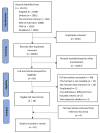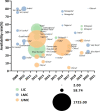Global, regional and national availability of essential medicines for children, 2009-2020: a systematic review and meta-analysis
- PMID: 37340382
- PMCID: PMC10280921
- DOI: 10.1186/s12889-023-15820-7
Global, regional and national availability of essential medicines for children, 2009-2020: a systematic review and meta-analysis
Abstract
Background: Access to essential medicines is a vital component of universal health coverage. The low availability of essential medicines for children (EMC) has led the World Health Organization (WHO) to issue a number of resolutions calling on member states on its improvement. But its global progress has been unclear. We aimed to systematically evaluate the progress of availability of EMC over the past decade across economic regions and countries.
Methods: We searched eight databases from inception to December 2021 and reference lists to identify included studies. Two reviewers independently conducted literature screening, data extraction and quality evaluation. This study was registered with PROSPERO, CRD42022314003.
Results: Overall, 22 cross-sectional studies covering 17 countries, 4 income groups were included. Globally, the average availability rates of EMC were 39.0% (95%CI: 35.5-42.5%) in 2009-2015 and 43.1% (95%CI: 40.1-46.2%) in 2016-2020. Based on the World Bank classification of economic regions, income was not proportional to availability. Nationally, the availability rate of EMC was reasonable and high (> 50%) in only 4 countries, and low or very low for the rest 13 countries. The availability rates of EMC in primary healthcare centers had increased, while that for other levels of hospitals slightly declined. The availability of original medicines decreased while that of generic medicines was stable. All drug categories had not achieved the high availability rate.
Conclusion: The availability rate of EMC was low globally, with slight increase in the last decade. Continuous monitoring and timely reporting of the availability of EMC are also needed to facilitate targets setting and inform relevant policy making.
Keywords: Availability; Children; Essential medicine; Systematic review.
© 2023. The Author(s).
Conflict of interest statement
The authors declare that they have no competing interests.
Figures







Similar articles
-
Availability of essential medicines, progress and regional distribution in China: a systematic review and meta-analysis.Front Public Health. 2023 Apr 25;11:1149838. doi: 10.3389/fpubh.2023.1149838. eCollection 2023. Front Public Health. 2023. PMID: 37181691 Free PMC article.
-
Availability and accessibility of cytotoxic medicines in the WHO model list of essential medicines for childhood cancer in low and lower-middle- income countries: a systematic review.BMC Cancer. 2025 Jan 31;25(1):181. doi: 10.1186/s12885-025-13586-2. BMC Cancer. 2025. PMID: 39891074 Free PMC article.
-
Beyond the black stump: rapid reviews of health research issues affecting regional, rural and remote Australia.Med J Aust. 2020 Dec;213 Suppl 11:S3-S32.e1. doi: 10.5694/mja2.50881. Med J Aust. 2020. PMID: 33314144
-
Access to Cardiovascular Disease and Hypertension Medicines in Developing Countries: An Analysis of Essential Medicine Lists, Price, Availability, and Affordability.J Am Heart Assoc. 2020 May 5;9(9):e015302. doi: 10.1161/JAHA.119.015302. Epub 2020 Apr 25. J Am Heart Assoc. 2020. PMID: 32338557 Free PMC article.
-
Prevalence and Estimated Economic Burden of Substandard and Falsified Medicines in Low- and Middle-Income Countries: A Systematic Review and Meta-analysis.JAMA Netw Open. 2018 Aug 3;1(4):e181662. doi: 10.1001/jamanetworkopen.2018.1662. JAMA Netw Open. 2018. PMID: 30646106 Free PMC article.
Cited by
-
Poor-tasting pediatric medicines: part 2. Exploring caregiver and healthcare provider values and preferences for a novel taste-blocker product to improve acceptability.Front Drug Deliv. 2025 Apr 22;5:1555522. doi: 10.3389/fddev.2025.1555522. eCollection 2025. Front Drug Deliv. 2025. PMID: 40837713 Free PMC article.
-
The availability of essential medicines in primary health centres in Indonesia: achievements and challenges across the archipelago.Lancet Reg Health Southeast Asia. 2024 Jan 8;22:100345. doi: 10.1016/j.lansea.2023.100345. eCollection 2024 Mar. Lancet Reg Health Southeast Asia. 2024. PMID: 38482146 Free PMC article.
References
-
- World Health Organization. Millennium Development Goals (MDGs). 2018. https://www.who.int/news-room/factsheets/detail/millennium-development-g.... Accessed 4 Nov 2022.
-
- World Health Organization. Better Medicines for Children. 2012. https://apps.who.int/iris/handle/10665/22030. Accessed 4 Nov 2022.
-
- World Health Organization. Promoting Innovation and Access to Quality, Safe, Efficacious and Affordable Medicines for Children. 2016. https://www.who.int/publications/i/item/promoting-innovation-and-access-.... Accessed 4 Nov 2022.
-
- World Health Organization. Children: improving survival and well-being. 2020. https://www.who.int/en/news-room/fact-sheets/detail/children-reducing-mo.... Accessed 4 Nov 2022.
Publication types
MeSH terms
Substances
LinkOut - more resources
Full Text Sources
Miscellaneous

